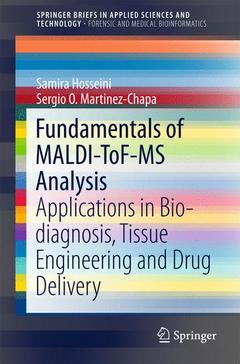Description
Fundamentals of MALDI-ToF-MS Analysis, 1st ed. 2017
Applications in Bio-diagnosis, Tissue Engineering and Drug Delivery
SpringerBriefs in Forensic and Medical Bioinformatics Series
Authors: Hosseini Samira, Martinez-Chapa Sergio O.
Language: English
Subjects for Fundamentals of MALDI-ToF-MS Analysis:
Keywords
Time of Flight Mass Spectrometry; Laser Range in MALDI; Dried-droplet Analysis; Electrospray Deposition; Ionizing Agent Selection; Fourier Transform Ion Cyclotron Resonance (FT-ICR); Size Exclusion Chromatograph (SEC); Tin Layer Chromatography (TLC); Synthesis of PMMA; Elastomeric Films and Coatings
Approximative price 52.74 €
In Print (Delivery period: 15 days).
Add to cartSupport: Print on demand
Description
/li>Contents
/li>Biography
/li>Comment
/li>
Fundamentals of MALDI-ToF-MS analysis
Abstract
1. 1 Background of MALDI-ToF-MS
1.2 Applications of MALDI-ToF-MS
1.2.1 Biochemistry
1.2.2 Organic chemistry
1.2.3 Polymer chemistry
1.2.4 Microbiology
1.2.5 Medicine
1.3 Ionization mechanism
1.4 Time of flight mass spectrometry mechanism
1.5 Detection modes
1.5.1 Linear mode
1.5.2 Reflection mode
1.6 Laser range in MALDI
1.7 Matrix selection
1.7.1 Limitations of matrices
1.8 Ionizing agent selection
1.9 Sample preparation
1.9.1 Analyzable and non-analyzable polymers
1.9.2 Sample preparation techniques
1.9.2.1. Dried-droplet
1.9.2.2. Fast crystallization
1.9.2.3. Spin coating
1.9.2.4. Layer by layer deposition
1.9.2.5. Electrospray deposition
1.10 Mass discrimination
1.10.1 Alternative solutions for overcoming mass discrimination
1.11 MALDI coupling
1.11.1 Ion-mobility time of flight mass spectrometry (IMS-TOF-MS)
1.11.2 Fourier transform ion cyclotron resonance mass spectrometry (FT-ICR-MS)
1.11.3 Tin layer chromatography (TLC)
1.11.4 Size exclusion chromatograph (SEC)
References
2 Application of MALDI-ToF-MS analysis in bio-diagnostic domain
Abstract
2.1 Biosensors
2.2 Synthesis of poly methyl methacrylate-co-methacrylic acid P(MMA-co-MAA) and
preparation of the biochips
2.3 Sample preparation for MALDI analysis
2.4 MALDI data interpretation
2.4.1 Different species as the possible products of soft ionization
2.4.2 General structure of P(MMA-co-MAA)
2.4.3 MALDI analysis of PMMA
2.4.4 MALDI analysis of P(MMA-co-MAA)
2.4.5 End-group analysis
2.5 Role of MALDI analysis in bio-sensing application of P(MMA-co-MAA)
2.5.1 Reaction's parameters
2.5.2 Chemistry aspect
2.5.3 Physical aspect
References
3 Application of MALDI-ToF-MS analysis in tissue engineering
Abstract
3.1 Tissue Engineering
3.2 Synthesis of poly octanediol citrate acid-sebacate acid P(OCS) and preparation of the
scaffold
3.3 MALDI analysis of P(OCS) and sample preparation
3.4 MALDI data interpretation
3.5 Role of MALDI analysis in tissue engineering application of P(OCS)
3.5.1 Reaction's parameters
3.5.2 Chemistry aspect
3.5.3 Mechanical aspect
References
4 Application of MALDI-ToF-MS analysis in drug delivery
Abstract
4.1 Drug delivery
4.2 Synthesis of PCLT-CA and preparation of elastomeric films and coatings
4.3 Sample preparation for MALDI analysis
4.4 MALDI data interpretation
4.5 The role of MALDI analysis in drug delivery application of PCLT-CA
4.5.1 Chemistry aspect
4.5.2 Mechanical aspect
References
Summary
Dr. Samira Hosseini obtained her BSc degree in Applied Physics, her MSc degree in Polymer Chemistry and her PhD degree in Biomedical Engineering. Currently, she is working as a Postdoctoral Researcher at School of Engineering and Sciences, Tecnológico de Monterrey, Mexico. Her main areas of research are surface engineering, interface science, bioanalytical systems and polymeric materials.
Sergio O. Martinez is a professor of Electrical and Computer Engineering at Tecnológico de Monterrey, Monterrey Campus; and Chair of the Sensors and Devices of the National School of Engineering and Sciences at the same Institute. He obtained his Ph.D. in Microelectronics from the National Polytechnic Institute of Grenoble, France in 2002. He is a member of the Mexican Research National System since 2004 and the Mexican Academy of Sciences since 2010. His recent research activities, focused on Micro/Nanotechnolgies, include Microfabrication Processes for Particle Manipulation Devices, Electrokinetically-driven Microdevices for Manipulation of Suspended Particles in Fluidic Media, and Modeling and Design of SPR-based Biosensing Platforms. He has been Principal Investigator in projects funded by CONACYT, the Mexican Economy Ministry, and the Bureau of Science and Technology of Nuevo Leon. He has authored/coauthored 75 peer-reviewed publications, 7 book chapters and 2 granted patents.
Includes supplementary material: sn.pub/extras




